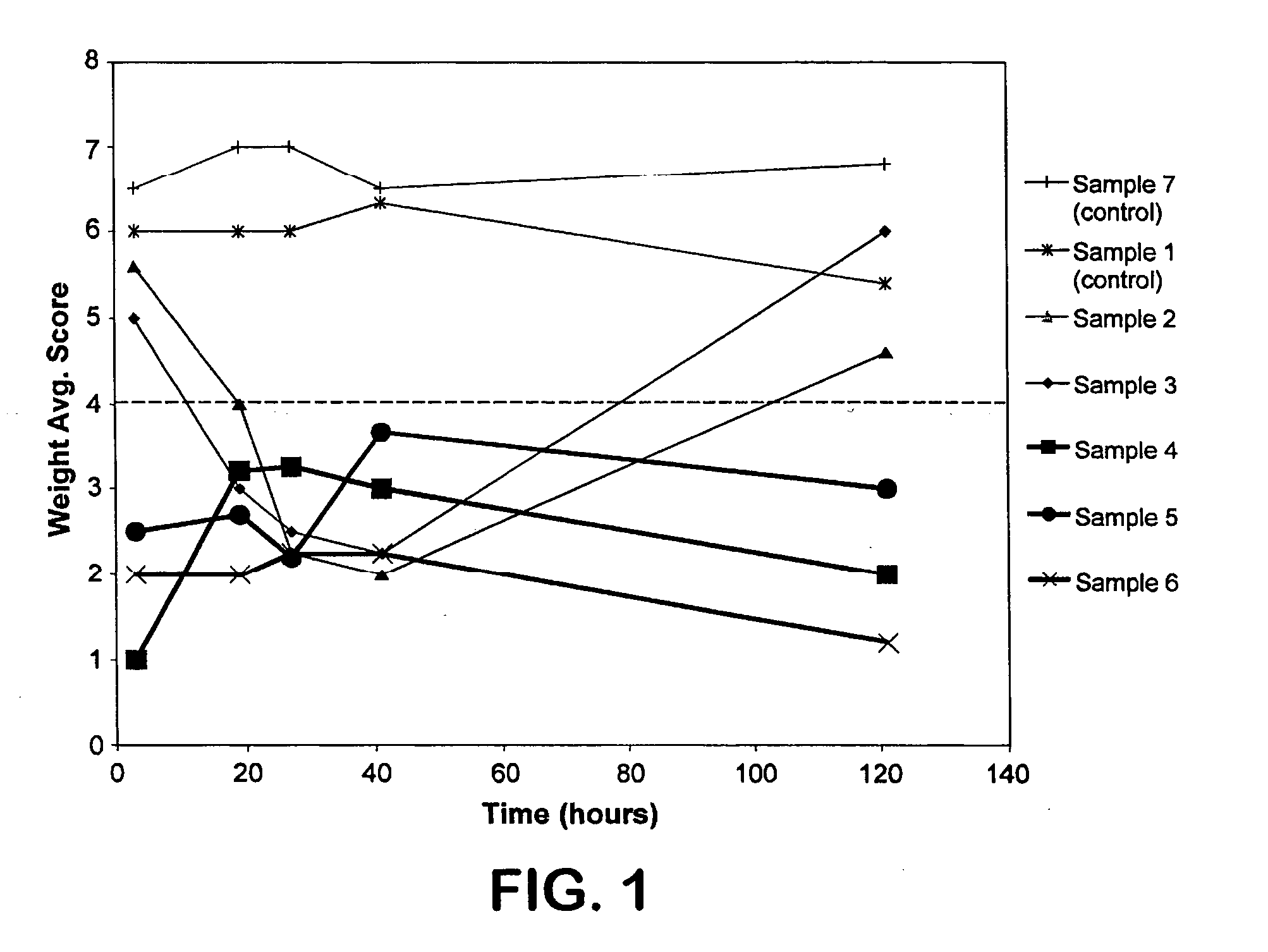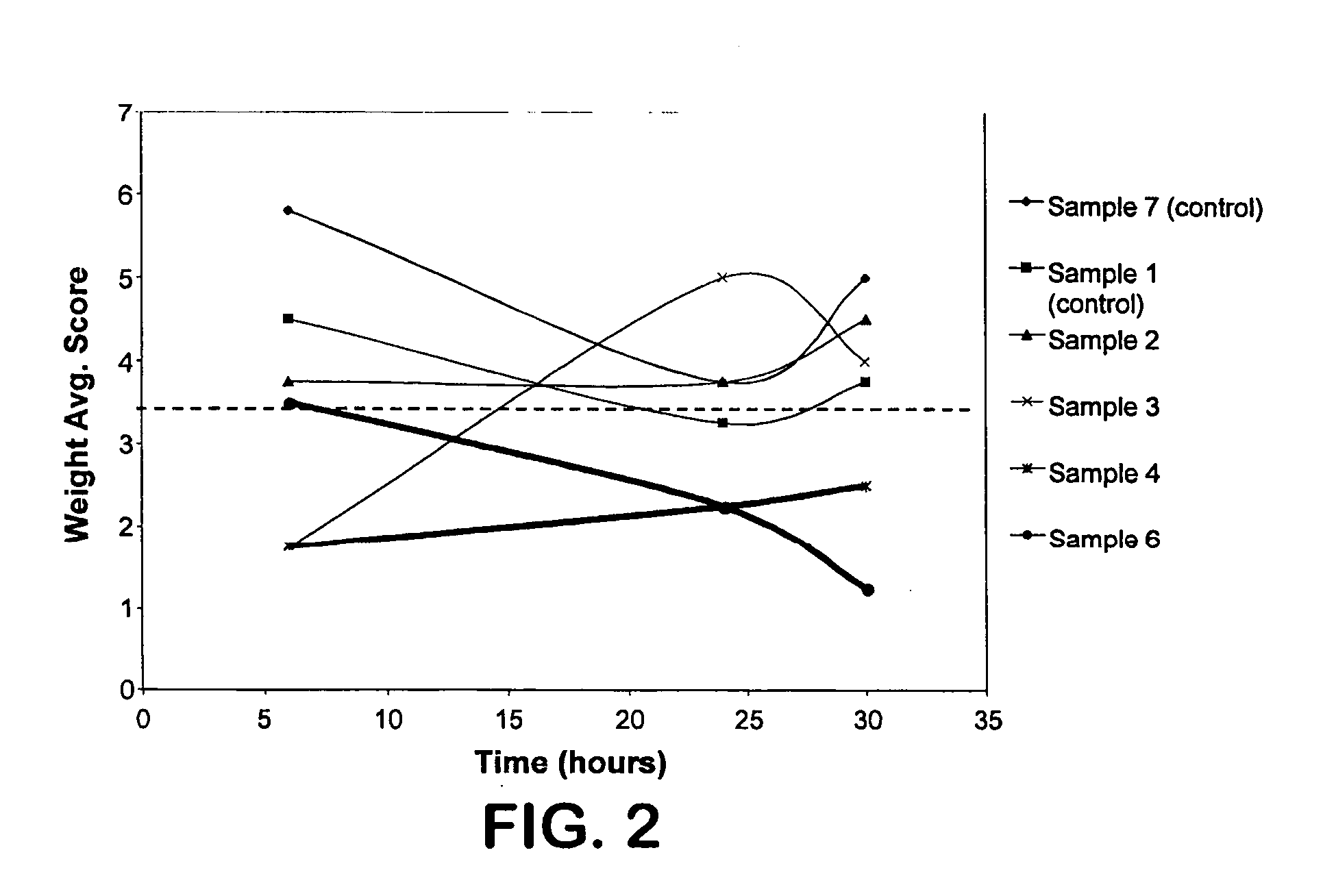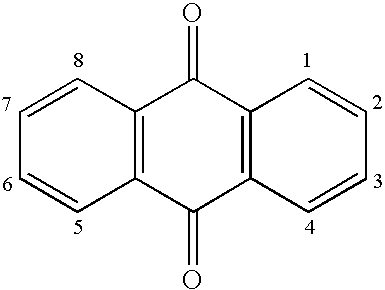Odor-reducing quinone compounds
a quinone compound and odor-reducing technology, applied in the direction of food ingredient nanoparticles, powder delivery, sheet delivery, etc., can solve the problems of ineffective odor control compositions, such as described above, in obtaining the full level of odor control desired in many applications, and achieve the effect of reducing odor, reducing odor, and high surface area particles
- Summary
- Abstract
- Description
- Claims
- Application Information
AI Technical Summary
Benefits of technology
Problems solved by technology
Method used
Image
Examples
example 1
[0058] The ability to coat a quinone compound onto a paper towel was demonstrated. Specifically, D&C Green No. 5 was initially dissolved into 1 liter of deionized water to form five sample solutions (Samples 2-6), wherein the concentration of D&C Green No. 5 varied from 0.001 wt. %, 0.01 wt. %, 0.1 wt. %, 0.25 wt. %, and 0.5 wt. %, respectively. Each solution also contained 1 wt. % of Snowtex AK (SN-AK) particles, which are colloidal silica nanoparticles coated with alumina and commercially available from Nissan Chemical America of Houston, Tex. The particles have an average particle size of between 10 to 20 nanometers and a surface area between 180 to 240 square meters per gram. A solution of only 1 wt. % of SN-AK particles was also formed as a control (Sample 1). Scott® paper towels (commercially available from Kimberly-Clark Corp.) were weighed, oven-dried overnight at 90° C., and weighed again the next day to calculate the amount of residual water in each towel. The towels were ...
example 2
[0060] The effectiveness of a quinone dye in reducing garlic odor was demonstrated. Initially, strips of each treated towel of Example 1 (Samples 2-6) were cut and placed in a jar with approximately 125 milligrams of freshly cut garlic. A strip from an uncoated Scott® paper towel (Sample 7), as well as the control towel of Example 1 (Sample 1), were also tested as controls. Garlic odor was assessed by a panel of individuals at intervals of 3, 19, 27, 41, and 121 hours. A score of “7” was assigned to the most malodorous jar and a score of “1” was assigned to the least malodorous jar. The results are shown in FIG. 1.
[0061] As shown, a line is drawn in FIG. 1 at the score of “4” to represent the level at which garlic malodor was perceived to be most dramatically reduced. The control samples did not reduce garlic odor and received almost unanimous scores of either 6 or 7. The dye concentrations of 0.1 wt. %, 0.25 wt. %, and 0.5 wt. % (Samples 4-6) were shown to be the most efficacious ...
example 3
[0062] The effectiveness of a quinone dye in reducing urine odor was demonstrated. Initially, strips of treated towels of Example 1 (Samples 2-4 and 6) were cut to the same size as the pledgefte area of a Poise® pad (commercially available from Kimberly-Clark Corp.). A strip from an uncoated Scott® paper towel (Sample 7), as well as the control towel of Example 1 (Sample 1), were also tested as controls. Poise® pads were then cut open, and the paper towel strips were placed within the tissue-wrap area. Thereafter, the tissue was rewrapped and the pad reassembled. The pads were placed in randomly labeled mason jars for testing with urine odor. Human female urine was then collected and pooled by a nurse on staff at Kimberly-Clark Corporation. The pooled urine was added to each pad in 50-milliliter aliquots using an automated pipette aid. The pads were allowed to soak in the urine at 37° C. and urine odor was assessed by a panel of individuals after 6, 24, and 30 hours. A score of “6” ...
PUM
| Property | Measurement | Unit |
|---|---|---|
| particle size | aaaaa | aaaaa |
| particle size | aaaaa | aaaaa |
| pore diameter | aaaaa | aaaaa |
Abstract
Description
Claims
Application Information
 Login to View More
Login to View More - R&D
- Intellectual Property
- Life Sciences
- Materials
- Tech Scout
- Unparalleled Data Quality
- Higher Quality Content
- 60% Fewer Hallucinations
Browse by: Latest US Patents, China's latest patents, Technical Efficacy Thesaurus, Application Domain, Technology Topic, Popular Technical Reports.
© 2025 PatSnap. All rights reserved.Legal|Privacy policy|Modern Slavery Act Transparency Statement|Sitemap|About US| Contact US: help@patsnap.com



